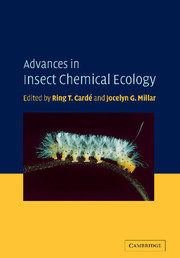Book contents
- Frontmatter
- Contents
- List of contributors
- Preface
- 1 Phytochemical diversity of insect defenses in tropical and temperate plant families
- 2 Recruitment of predators and parasitoids by herbivore-injured plants
- 3 Chemical ecology of astigmatid mites
- 4 Semiochemistry of spiders
- 5 Why do flowers smell? The chemical ecology of fragrance-driven pollination
- 6 Sex pheromones of cockroaches
- 7 A quest for alkaloids: the curious relationship between tiger moths and plants containing pyrrolizidine alkaloids
- 8 Structure of the pheromone communication channel in moths
- Index
- References
4 - Semiochemistry of spiders
Published online by Cambridge University Press: 07 August 2009
- Frontmatter
- Contents
- List of contributors
- Preface
- 1 Phytochemical diversity of insect defenses in tropical and temperate plant families
- 2 Recruitment of predators and parasitoids by herbivore-injured plants
- 3 Chemical ecology of astigmatid mites
- 4 Semiochemistry of spiders
- 5 Why do flowers smell? The chemical ecology of fragrance-driven pollination
- 6 Sex pheromones of cockroaches
- 7 A quest for alkaloids: the curious relationship between tiger moths and plants containing pyrrolizidine alkaloids
- 8 Structure of the pheromone communication channel in moths
- Index
- References
Summary
Introduction
Spiders are an important order of carnivorous arachnids having a great impact on many ecosystems. Because most of their prey consists of insects, they can play an important role in controlling pest insects in agricultural crops. There are currently about 36 000 described species, out of an estimated overall number of 60 000–80 000 species (Platnick, 1999). Unlike the situation with insects (Francke and Schulz, 1999), pheromones and other semiochemicals of arachnids, and especially spiders, have received little attention from researchers. What information is available on the use of semiochemicals by spiders will be reviewed and discussed in this chapter.
Spider pheromones
Spiders are not well known for their ability to communicate with pheromones, partly because of their relatively restricted movement compared with flying insects. Such limited motility makes observations of such phenomena less straightforward. Furthermore, few spider species are serious pests, and far more research has been focussed on their elaborate use of silk, which has fascinated humans for millenia. However, the problem of finding mates is essentially the same for both insects and spiders. That is, a relatively small animal living in a spacious environment needs efficient mechanisms to find a mate for reproduction. Flying insects are better equipped to respond to olfactory cues for mate location, being free to move in three dimensions, whereas spiders are often restricted to walking on vegetation, which makes it more difficult to follow odor plumes through complex plant architecture.
- Type
- Chapter
- Information
- Advances in Insect Chemical Ecology , pp. 110 - 150Publisher: Cambridge University PressPrint publication year: 2004
References
- 50
- Cited by



